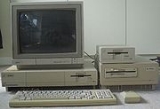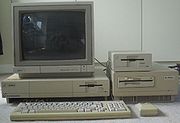
Amiga Sidecar
Encyclopedia

Commodore International
Commodore is the commonly used name for Commodore Business Machines , the U.S.-based home computer manufacturer and electronics manufacturer headquartered in West Chester, Pennsylvania, which also housed Commodore's corporate parent company, Commodore International Limited...
A1060 Sidecar is an expansion hardware device developed by Commodore and released in 1986 for the Amiga 1000
Amiga 1000
The A1000, or Commodore Amiga 1000, was Commodore's initial Amiga personal computer, introduced on July 23, 1985 at the Lincoln Center in New York City....
computer. It features a complete PC XT system mounted in an expansion case which connected to the expansion bus on the right side of the Amiga 1000 computer, sitting beside it similar to a motorcycle's sidecar
Sidecar
A sidecar is a one-wheeled device attached to the side of a motorcycle, scooter, or bicycle, producing a three-wheeled vehicle.-History:A sidecar appeared in a cartoon by George Moore in the January 7, 1903, issue of the British newspaper Motor Cycling. Three weeks later, a provisional patent was...
.
The PC side of the Sidecar was built around an Intel 8088
Intel 8088
The Intel 8088 microprocessor was a variant of the Intel 8086 and was introduced on July 1, 1979. It had an 8-bit external data bus instead of the 16-bit bus of the 8086. The 16-bit registers and the one megabyte address range were unchanged, however...
processor. All I/O
I/O
I/O may refer to:* Input/output, a system of communication for information processing systems* Input-output model, an economic model of flow prediction between sectors...
procedures from the PC side are performed by the Amiga. Software was included to allow data to be exchanged easily between the PC and the Amiga side of the system. The Sidecar was available with an internal hard disk
Hard disk
A hard disk drive is a non-volatile, random access digital magnetic data storage device. It features rotating rigid platters on a motor-driven spindle within a protective enclosure. Data is magnetically read from and written to the platter by read/write heads that float on a film of air above the...
which was accessible from both the MS-DOS
MS-DOS
MS-DOS is an operating system for x86-based personal computers. It was the most commonly used member of the DOS family of operating systems, and was the main operating system for IBM PC compatible personal computers during the 1980s to the mid 1990s, until it was gradually superseded by operating...
and AmigaOS
AmigaOS
AmigaOS is the default native operating system of the Amiga personal computer. It was developed first by Commodore International, and initially introduced in 1985 with the Amiga 1000...
environments. This was the first hard drive produced by Commodore for the Amiga.
Video display and user input were performed through the Amiga's monitor, keyboard, and mouse. This allows the user to control both computers simultaneously.
Characteristics
The Amiga Sidecar was a complete IBM PC XT system, with the exception of I/O devices and operations which are handled by the Amiga.- Processor: Intel 8088 clocked at 4.77 MHz
- RAM: 256K (expandable to 512K + 80K Dual Bus Memory)
- Graphics Emulation: Dependent on Amiga settings. (Can use real 8bit ISA graphics cards)
- Sound Emulation: Dependent on Amiga settings. (can use real 8bit ISA sound cards)
- One internal 5.25" drive bayDrive bayA drive bay is a standard-sized area for adding hardware to a computer. Most drive bays are fixed to the inside of a case, but some can be removed....
normally fitted with a 360K 5.25" floppy drive - 3 x 8bit ISA slots for using real PC cards
- Amiga 1000 Expansion Bus connector (for Amiga connectivity)
History
Early in its life, the Amiga was strong in entertainment and graphics software but lacked general productivity software such as word processorWord processor
A word processor is a computer application used for the production of any sort of printable material....
s, spreadsheet
Spreadsheet
A spreadsheet is a computer application that simulates a paper accounting worksheet. It displays multiple cells usually in a two-dimensional matrix or grid consisting of rows and columns. Each cell contains alphanumeric text, numeric values or formulas...
s and database software. These are the areas where the de facto business standard IBM PC excelled. Commodore's intent was to let the Amiga take advantage of PC compatibility to shore up its weakness in this category of software.
The Sidecar was developed by Commodore Germany, as all of the Commdore PC-architecture based development was performed in that department.
The Sidecar was relatively expensive and it required a non-trivial amount of desktop space compared to the Amiga 1000 by itself. The device was also taller than the Amiga 1000, which made it seem even further disconnected to the main system, aesthetically.
Besides the high price and the aesthetic issues, other factors contributed to the lack of adoption of the Sidecar. Newer Amiga models like the Amiga 2000
Amiga 2000
The Amiga 2000, or A2000, is a personal computer released by Commodore in 1986. It is the successor to the Amiga 1000.-Features:Aimed at the high-end market, the original Europe-only model adds a Zorro II backplane, implemented in programmable logic, to the custom Amiga chipset used in the Amiga 1000...
provided internal expansion slots, with the optional Bridgeboard expansion card replacing the functionality of the Sidecar, but without the need for a bulky external chassis. The popular Amiga 500
Amiga 500
The Amiga 500 - also known as the A500 - was the first “low-end” Commodore Amiga 16/32-bit multimedia home/personal computer. It was announced at the winter Consumer Electronics Show in January 1987 - at the same time as the high-end Amiga 2000 - and competed directly against the Atari 520ST...
could not be used with the Sidecar at all, due to the expansion slot on the A500 residing on the left side of the chassis, as opposed to the right side on the A1000. Also, decent business and productivity software began to be released for AmigaOS
AmigaOS
AmigaOS is the default native operating system of the Amiga personal computer. It was developed first by Commodore International, and initially introduced in 1985 with the Amiga 1000...
, reducing the need to run MS-DOS applications on the Amiga. Simultaneously, the ever-decreasing cost of IBM PC compatible
IBM PC compatible
IBM PC compatible computers are those generally similar to the original IBM PC, XT, and AT. Such computers used to be referred to as PC clones, or IBM clones since they almost exactly duplicated all the significant features of the PC architecture, facilitated by various manufacturers' ability to...
hardware, along with that platform's growing entertainment and graphics software base, began to make the PC a viable competitor in areas where the Amiga had typically held an edge.

